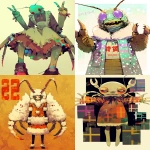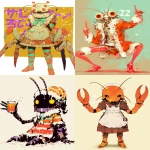Explore the Best AI Image Gallery

The Algorithmic Palette: Exploring AIs Impact on Graphic Design
The realm of graphic design is undergoing a seismic shift, driven by the burgeoning field of artificial intelligence (AI). From generating stunning visuals to automating tedious tasks, AI is rapidly becoming an indispensable tool for designers, reshaping the creative landscape and blurring the lines between human ingenuity and machine learning.
A New Era of Creative Possibilities
AI-powered design tools are empowering creators with unprecedented capabilities. Generative algorithms can produce unique and captivating designs based on user prompts or existing styles, enabling designers to explore novel concepts and push the boundaries of creativity. Imagine inputting a few keywords and receiving a range of visually compelling options, tailored to your specific needs.
These tools are particularly beneficial for tasks that traditionally consume significant time and effort, such as creating logos, social media graphics, or website layouts. AI can handle the repetitive aspects of design, freeing up designers to focus on higher-level creative problem-solving and conceptualization.
Applications Across the Design Spectrum
The applications of AI in graphic design are vast and diverse, spanning various domains:
- Logo Design: AI can generate multiple logo concepts based on a brands identity, target audience, and desired aesthetics.
- Social Media Graphics: Create eye-catching visuals for platforms like Instagram, Facebook, and Twitter, tailored to specific campaigns or themes.
- Website Design: Generate website layouts and mockups, incorporating responsive design principles and user-friendly navigation.
- Illustration and Iconography: Produce unique illustrations and icons in various styles, from realistic to abstract.
- Typography and Font Design: Experiment with different font combinations and explore innovative typographic treatments.
Ethical Considerations: Navigating the AI Frontier
While AI presents tremendous opportunities for graphic design, its crucial to address the ethical implications associated with its use:
- Copyright and Intellectual Property: Questions arise regarding ownership and copyright of designs generated by AI. Establishing clear guidelines and regulations is essential.
- Bias and Representation: AI algorithms are trained on existing data, which may contain biases that reflect societal stereotypes. Designers must be mindful of these potential biases and strive for inclusivity and diversity in their work.
- Transparency and Explainability: The decision-making processes of some AI models can be opaque. Increasing transparency and understanding how AI generates designs is crucial for accountability and trust.
The Future of Design: A Collaborative Landscape
The future of graphic design lies in a harmonious collaboration between human creativity and AI-powered tools.
AI will augment the capabilities of designers, enabling them to produce more innovative and impactful work. Humans will retain their essential role in conceptualizing ideas, setting creative direction, and ensuring that designs align with ethical considerations and user needs.
This symbiotic relationship between human and machine will drive the evolution of graphic design, leading to a future where creativity knows no bounds.





](https://images.ai-img.art/thumbnails/150/124afc0facac1c0c676099ab4d2aae88da73c9ba0b89d1f6de454d8b236458ef.webp)
